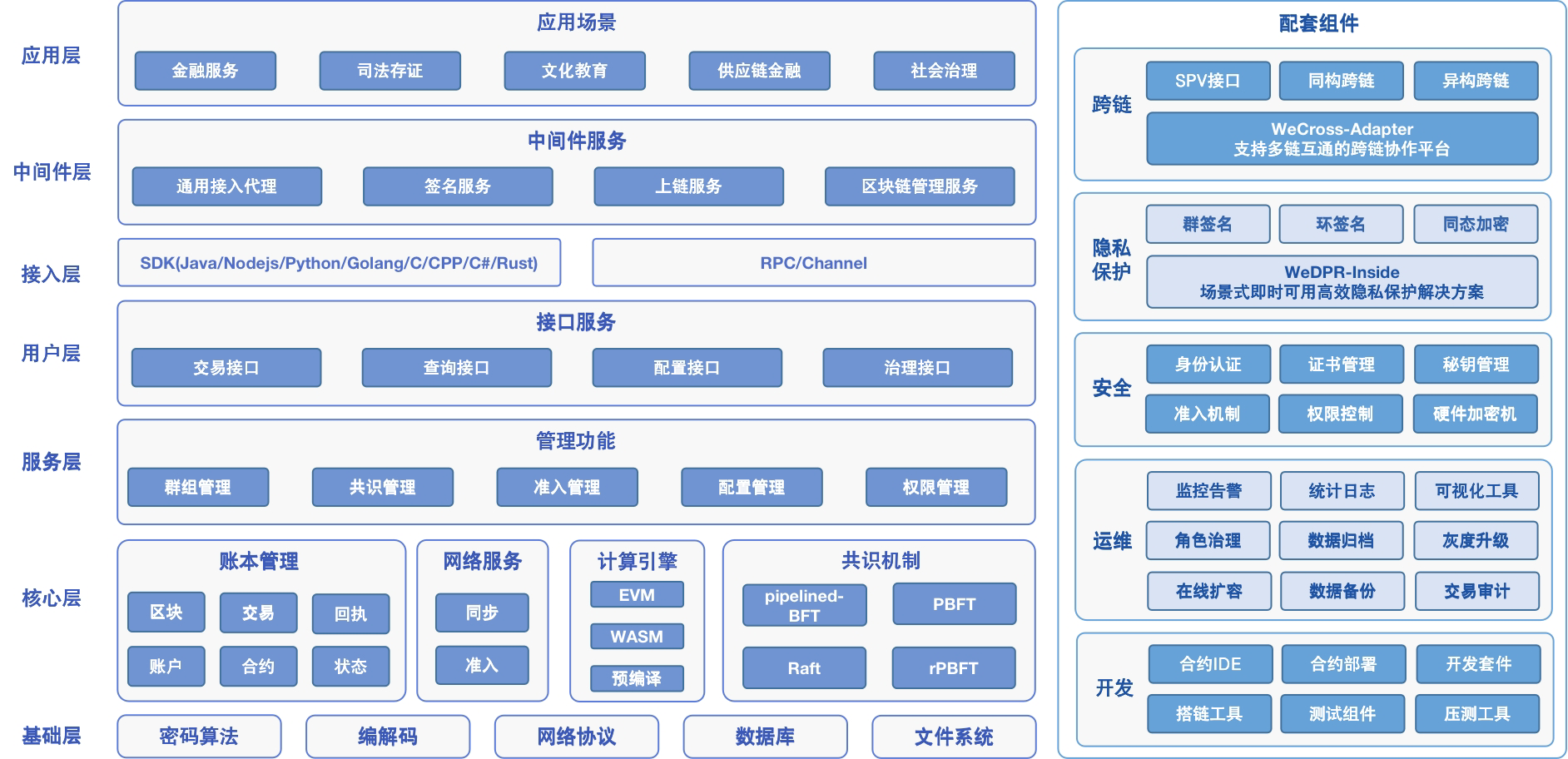中文 / English
FISCO BCOS(读作/ˈfɪskl bi:ˈkɒz/) 是一个稳定、高效、安全的区块链底层平台,由微众银行牵头的金链盟主导研发,其可用性经广泛应用实践检验。至今已涌现300+产业数字化标杆应用,覆盖金融、医疗、教育、文化、社会治理等领域,如珠三角征信链、区块链服务网络BSN、人民链、国家健康医疗大数据科创平台、粤澳健康码跨境互认系统等。
单链配置下,性能TPS可达10万+。全面支持国密算法、国产操作系统与国产CPU架构。包含区块流水线、可拔插共识机制、全方位并行计算、区块链文件系统、权限治理框架、分布式存储等特性。
- 稳定版本(生产环境使用):v3.2.7,版本内容可参考《FISCO-BCOS v3.2.7版本说明》
- 最新版本(用户体验新特性):v3.8.0,版本内容可参考 《FISCO-BCOS v3.8.0版本说明》
FISCO BCOS系统架构包括基础层、核心层、服务层、用户层和接入层提供稳定、安全的区块链底层服务。中间件层通过可视化界面,简化了用户管理区块链系统的流程。右侧配套相关开发、运维、安全控制的组件,辅助应用落地过程中不同角色的需要;同时,提供隐私保护和跨链相关的技术组件,满足不同场景的应用诉求。
- Pipelined:区块流水线,连续且紧凑地生成区块
- 可插拔的共识机制: 设计可插拔共识框架,灵活可选
- 全方位并行计算:多群组,块内分片,DMC,DAG等并行机制,实现强大处理性能。
- 区块链文件系统: 所见即所得的合约数据管理
- 权限治理框架:内置权限治理框架,多方投票治理区块链
- 分布式存储 TiKV:分布式事务性提交,支撑海量存储
- SDK基础库:多语言SDK,更方便的全平台国密接入
- 隐私保护:场景式即使可用隐私保护解决方案WeDPR
- 跨链协作:支持多链互通的跨链协作平台WeCross
- 区块链管理:可视化的区块链管理平台WeBASE
- 搭链工具:一键建链脚本,自动化部署区块链
- 可视化工具:提供可视化管理工具,减少操作流程
- 监控告警工具:监控区块链系统运行状态,实时告警
- 数据归档工具:冷数据归档,支持RocksDB和TiKV,释放存储压力
《FISCO BCOS官方技术文档》提供建链开发指引、工具介绍以及设计原理解析,用户可通过阅读官方技术文档快速了解、使用FISCO BCOS。
若需查阅FISCO BCOS 2.x版本相关信息,可参考 《FISCO BCOS 2.x 技术文档》
以数助实,链通产业协作,FISCO BCOS已落地400+产业数字化标杆应用,场景覆盖文化版权、司法服务、政务服务、物联网、金融、智慧社区、房产建筑、社区治理、乡村振兴等领域,如:
- 金融业:机构间对账、供应链金融、旅游金融等。
- 司法存证:仲裁链、电子借据、司法存证平台等。
- 文化版权:版权存证与交易、虎彩印刷链等。
- 社会管理:不动产登记、社区治理等。
- 乡村振兴:智慧农业养殖大数据云平台、数字化平台建设等。
- 智慧政务:城市大脑、公积金区块链平台、证书电子化项目等
FISCO BCOS已在领域创建了诸多标杆应用示范,涵盖19类场景的252个典型应用案例,产业应用具体信息可参考《2023 FISCO BCOS 产业应用发展报告》。
FISCO BCOS开源社区 FISCO BCOS是由深圳市金融区块链发展促进会(以下简称“金链盟”)开源工作组牵头研发的金融级、国产安全可控的区块链底层平台。作为最早开源的国产联盟链底层平台之一,FISCO BCOS于2017年面向全球开源。
开源六周年至今,FISCO BCOS开源社区在技术创新、应用产业以及开源生态均取得了非凡成绩。
FISCO BCOS持续攻关核心关键技术,单链性能突破10万TPS。首创DMC算法大幅度提升性能、推出三种架构形态灵活适配业务需求;全链路国产化,采用国密算法与软硬件体系,支持国产OS,适配国产芯片和服务器,支持多语言多终端国密接入。拥有覆盖底层+中间件+应用组件的丰富周边组件。
底层平台可用性已经广泛应用实践检验,支撑政务、金融、医疗、双碳、跨境数据通等关乎国计民生的重点领域落地超过400个标杆应用,在助力实体经济发展、促进公平与可持续等方面贡献力量。
社区以开源链接多方,截止2023年12月,围绕FISCO BCOS构建的国产开源联盟链生态圈已汇聚了超过5000家机构、超10万名个人成员,以及50家认证合作伙伴、500余名核心贡献者。社区认证了63位FISCO BCOS MVP, 发展了12个专项兴趣小组SIG,此外与上百所知名院校开展人才共育合作,培育区块链产业人才超8万人次,已发展成为最大最活跃的国产开源联盟链生态圈之一。
如您对FISCO BCOS开源技术及应用感兴趣,欢迎加入社区获得更多支持与帮助。
-
我们欢迎并非常感谢您的贡献,请参阅代码贡献流程。
-
如项目对您有帮助,欢迎star支持!
FISCO BCOS的开源协议为Apache License 2.0, 详情参见LICENSE。




